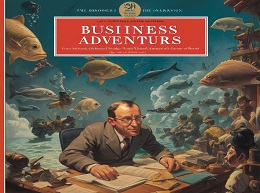Where Good Ideas Come From: The Natural History of Innovation

Understanding the Genesis of Innovation
Steven Johnson's "Where Good Ideas Come From: The Natural History of Innovation" presents a compelling exploration of how groundbreaking ideas emerge and evolve. Through a rich tapestry of historical examples, scientific research, and insightful analysis, Johnson identifies the common patterns and environments that have consistently nurtured innovation throughout human history. This review delves into the core concepts of the book, illustrating how they apply to modern innovation and providing engaging examples that bring these ideas to life.
Concept of the Adjacent Possible
One of the central themes in Johnson's book is the concept of the "adjacent possible," a term borrowed from theoretical biologist Stuart Kauffman. This idea suggests that at any given moment, the future is a set of possibilities that are constrained by the present state but also expansive enough to allow for new and unexpected developments.
The Evolution of Technology
Consider the development of the smartphone. Early mobile phones were simple communication devices. However, as technology advanced, new possibilities emerged. The integration of cameras, internet connectivity, and touchscreens transformed these devices into powerful, multi-functional tools. Each innovation expanded the adjacent possible, leading to the sophisticated smartphones we use today.
The Importance of Diverse Connections
Johnson argues that "liquid networks" – environments where information flows freely and ideas can easily connect and recombine – are crucial for fostering innovation. These networks thrive in diverse and densely connected spaces where different perspectives can intersect and interact.
The Creative Hubs of Silicon Valley
Silicon Valley exemplifies a liquid network. The region's dense concentration of tech companies, universities, and venture capital firms creates an ecosystem where ideas and talent flow freely. This connectivity has led to a continuous stream of innovations, from personal computing to social media platforms, demonstrating the power of liquid networks in driving progress.
Gradual Development of Ideas
Johnson introduces the idea of the "slow hunch," suggesting that many great innovations develop over long periods, rather than emerging as sudden epiphanies. These slow hunches require time to mature, often needing multiple pieces to come together before the full potential of an idea is realized.
Charles Darwin's Theory of Evolution
Charles Darwin's theory of evolution by natural selection is a classic example of a slow hunch. Darwin spent over two decades collecting evidence, refining his ideas, and synthesizing information from various sources before publishing "On the Origin of Species." This gradual process allowed his groundbreaking theory to take shape and withstand scientific scrutiny.
Embracing Unexpected Discoveries
Serendipity plays a significant role in innovation, as unexpected discoveries can lead to new insights and breakthroughs. Johnson emphasizes the importance of being open to these chance encounters and allowing them to influence the direction of one's work.
The Discovery of Penicillin
The discovery of penicillin by Alexander Fleming is a prime example of serendipity in action. In 1928, Fleming noticed that a mold called Penicillium notatum had contaminated his petri dishes and killed the surrounding bacteria. This chance observation led to the development of antibiotics, revolutionizing medicine and saving countless lives.
The Productive Power of Errors
Johnson highlights the productive power of errors, noting that mistakes and failures often lead to new pathways of thinking and unexpected solutions. Embracing errors as part of the creative process allows for iterative improvement and innovation.
Post-it Notes
The invention of Post-it Notes by 3M is a testament to the value of errors. Scientist Spencer Silver was trying to create a super-strong adhesive but ended up with a weak, reusable one instead. This "failed" experiment eventually led to the creation of Post-it Notes, a product that has become ubiquitous in offices and homes around the world.
Borrowing and Adapting Concepts
Exaptation refers to the process of repurposing existing ideas or technologies for new uses. Johnson shows how many innovations result from applying concepts from one field to another, thereby opening up new possibilities.
The Development of the Printing Press
Johannes Gutenberg's printing press was an exaptation of existing technologies. He combined the wine press with movable type, a concept borrowed from coin punch technology, to create a machine that revolutionized the spread of information. This cross-pollination of ideas dramatically increased literacy and knowledge dissemination, shaping the modern world.
The Layering of Innovations
Johnson discusses how platforms – foundational innovations that create the groundwork for future developments – are critical to the innovation process. These platforms provide the necessary infrastructure for subsequent innovations to build upon.
The Internet as a Platform
The internet serves as a quintessential platform. Initially developed as a means of communication for researchers, it has since evolved into a global infrastructure supporting countless innovations, from e-commerce to social media. Companies like Amazon, Google, and Facebook have all leveraged the internet as a platform to create transformative business models and services.
Cultivating Innovation-Friendly Environments
"Where Good Ideas Come From: The Natural History of Innovation" by Steven Johnson provides a comprehensive exploration of the factors that foster creativity and innovation. By examining historical examples and identifying common patterns, Johnson offers valuable insights into how environments that encourage connectivity, diversity, and serendipity can lead to groundbreaking ideas.
Final Thoughts:
The book's rich narrative and well-researched content make it a must-read for anyone interested in understanding the origins of innovation. Whether you are an entrepreneur, educator, or simply curious about the creative process, Johnson's work offers profound lessons on how to cultivate and nurture good ideas. By embracing the principles outlined in "Where Good Ideas Come From," individuals and organizations can create environments that are conducive to innovation, ultimately driving progress and transformation in various fields.













